People, science is your friend. Vaccinations are not only for the benefit of yourself, but for others. Anyway, let us take a look at the measles outbreak through some graphics produced by the New York Times. It started in Disneyland. Because we had eliminated the disease about 15 years ago. Science, people.

Credit for the piece goes to Jonathan Corum, Josh Keller, Haeyoun Park, and Archie Tse.










